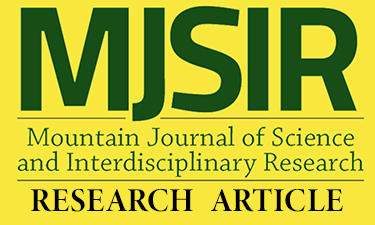Teaching Strategy to Enhance Information and Communication Technology (ICT) Instructional Skills
Main Article Content
Abstract
The progression of Information and Communication Technology (ICT) use has kindled new ways of learning. Effectiveness of new strategies of learning needs to be scientifically tested to assure their efficacy in instruction. The study aimed to look into the influence of blended learning environment on the pre-service teachers’ ICT instructional skills. Respondents of the study were pre-service teachers enrolled in Benguet State University. The study employed the static pretest-posttest control group experimental research design. Descriptive and inferential statistics were used to treat the data. Research findings revealed that pre-service teachers’ performance before and after the conduct of face-to-face and blended modes of learning exhibited substantial increase in their learning. Exceedingly high learning result along use of blended mode were disclosed along technology literacy, knowledge deepening, knowledge creation, use of ICT to introduce new lessons and use of ICT to extend learning. Similarly, comparable learning results along face-to-face mode of learning were noted along technology literacy, knowledge deepening, knowledge creation, use of ICT to introduce new lessons, reinforce learning, and use of ICT to supplement knowledge. The use of both face-to-face and blended modes of learning led to significant acceleration of ICT skills development of pre-service teachers. Learning gains between blended learning and face-to-face modes learning are comparable. They are likewise complementary in developing the pre-service teachers’ ICT instructional skills
Article Details
References
Bailey, J., Ellis, S., Schneider, C. & Ark, T.V. (2013). Blended Leanring Implementation Guide. Version 1.0. Retrieved from http://www.faith formationlearningexchange.net/uploads/5/2/ 4/6/5246709/blended_learning_implementation _guide.pdf
CMO 52, series 2007. (2007). Addendum to CMO 30, Series of 2004 entitled "Revised Policies and Standards for Undergraduate Teacher Educaiton Curriculum. Commission on Higher Education.
Cox, M., Abbot, C., Webb, M., Blakeley, B., Beauchamp, T., & Rhodes, V. (2004). ICT Research: A review of the research literature relating to ICT and attainment. Retrieved from http://dera.ioe.ac.uk/1600/1/becta_2003_ attainmentreview_queensprinter.pdf
Dziuban, C.H, Hartman, J. & Moskal, P. (2004). Blended Learning. EDUCAUSE Center for Applied Research (ECAR) Research Bulletin (7). 1-12.
Earle, R. (2002). The Integration of Instructional Technology into Public Education: Promises and Challenges. Educational Technology. Educational Technology, 5-13. Retrieved from https://eric. ed.gov/?id=EJ645687
Felea, C. (2013). Blended Learning and ICT Integration in Higher Education: The case of Babe-Bolyai University. Retrieved January 2016, from http://www.academia.edu/3296277/ Blended_Learning_and_ICT_Integration._The_ Case_for_Babes-
Bolyai_University
Fraenkel, J.r., Wallen, N.E., & Hyun, H.H. (2013). How to Design and Evaluate Research in Education. New York: McGraw-Hill Educaiton.
Garrison, D.R. & Kanuka, H. (2004). Blended Learning: Uncovering its transformative potential in higher education. The Internet and Higher Education, 95-105.
Garrison, R.D., & Vaughan, N.D. (2007). Blended learning in higher education: Framework, principles, and guidelines. San Francisco, CA: Jossey-Bass, Inc.
International Business Machines Corporation (IBM). (2002). Implementing the 4-tier blended learning model form IBM. Retrieved March 2016, from ftp://service.boulder.ibm.com/software/lotus/pub/lotusweb/lspace/LSP- 2002-022-B.pdf
Jacob, L. & Larsen, E. (2012). Teacher and student perspectives on a blended learning intensive English program writing course. Retrieved February 2016, from http://lib.dr.iastate.edu/ cgi/viewcontent.cgi?article=3382&context=etd
Jung, I. (2005). ICT-Pedagogy Integration in Teacher Training: Application Cases Worldwide. Educational Technology & Society, 8(2), 94-101.
Lubrica, P.A., Alvaro, M.N., Angiwan, E.S., Capili, A.C., Cawat, A. C., Luma-ang, C.P., Montemayor, JL. S., Singa, V.P., & Yango, D.M. (2012). Benchmarking on the Use of Instructional Media Among Teachers of Teacher in the Cordillera Administrative Region.
Research and Educational Development Training Institute (ISSN 1656-166X), 463-461.
Mandell, S., Sorge, D.H., & Russell, J.D. (2002). Tips for technology integration. TechTrends, 37(2), 39-43.
Marquis, C. (2004). WebCT survey discovers a blend of online learning and classroom-based teaching is the most effective form of learning today. Retrieved from WebCT.com.
Robinson, B., & Latchem, C. (2003). Teacher education: challenges and change. In B. Robinson, & C. Latchem (Eds.), Teacher Education thourgh open and distance learning. RoutledgeFalmer, 1-27.
Rosset, A. & Frazee, R.V. (2006). Blended learning opportunities. AMA Special Report. Retrieved December 2015, from http://www. amanet.org/training/seminars/BlendedLearningOpporunities-45.aspx.
Sarvery, J. R., & Duffy, T.M. (1995). Problem based learning: An instructional model and its constructivist framework. Educational Technology, 35(5), 31-38.
Sparks, S. (2015). Education Week. Retrieved from https://www.edweek.org/ew/articles/2015/04/ 15/blended-learning-research-yields-limitedresults.html
Swan, K. & Ice, P. (2010). The Community of Inquiry framework ten years later: introduction to the special issue. Internet and Higher Educaiton, 13(1-2), 1-4. Retrieved from https://www. ideals.illinois.edu/bitstream/handle/2142/18714
/INTHIG%20369%20INTRO.pdf?sequence=2
Tan, M. (2015). ICT and Deep Learning Skills for Better Education. Retrieved February 2016, from https://www.britishcouncil.ph/sites/default/ files/ melizza_tan_ict_competencies_ needed_ for_21st_century.pdf
UNESCO. (2011). UNESCO Competency Framework for Teachers. Retrieved from http://www.unesco. org/new/en/communication-and-information/ resources/publications-and-communicationmaterials/publications/full-list/unesco-ictcompetency-framework-for-
teachers/
UNESCO. (2015). ICT Competencies for Teachers. Retrieved from https://www.britishcouncil.ph/ sites/default/files/melizza_tan_ict_compe tencies_needed_for_21st_century.pdf
Vaughan, N. (2007). Perspectives on Blended Learning in Higher Education . International Journal on E-Learning, 6nl, 81-94 . Retrieved from https://eric.ed.gov/?id=EJ747810
Wang, Q., & Woo, H.L. (2007). Systematic Planning for ICT Integration in Topic Learning. Educational Technology & Society, 10(1), 148-156. Retrieved from http://ifets.info/ journals/10_1/14.pdf
Yerasimou, T. (2000). Examining interactivity and flow in a blended course to advance blended learning practices. Ann Arbor, MI:Proguest Dissertations Publishing.

